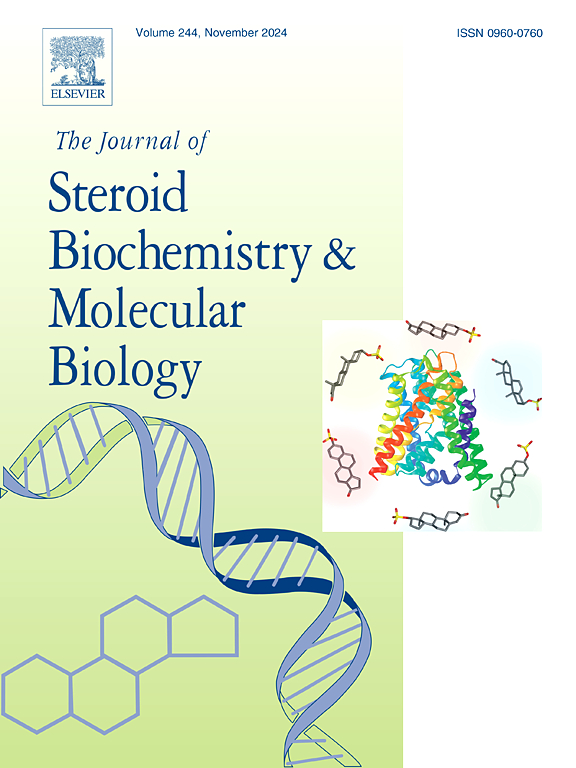Design, synthesis, and biological evaluation of estratriene-based hydroxamic acid derivatives as histone deacetylase inhibitors
IF 2.5
2区 生物学
Q3 BIOCHEMISTRY & MOLECULAR BIOLOGY
Journal of Steroid Biochemistry and Molecular Biology
Pub Date : 2025-09-22
DOI:10.1016/j.jsbmb.2025.106867
引用次数: 0
Abstract
A series of estratriene-based hydroxamic acid derivatives were rationally designed as histone deacetylase (HDAC) inhibitors, utilizing estrone and estradiol scaffolds with hydroxamic acid groups attached at the 3-position via alkoxy linkers of varying chain lengths. Structure-activity relationship studies indicated that compounds with n = 4 exhibited optimal activity. The lead compounds CFT-2b and CEC-2b showed potent antiproliferative effects against HeLa and SKOV-3 cells (IC50, 6.09–8.36 μM) and favorable selectivity indices (8.5 to >13.1 versus 293 T cells). Notably, several compounds showed superior HDAC inhibitory activity compared to SAHA. Mechanistic studies showed that CFT-2b and CEC-2b induced dose-dependent apoptosis, caused G1-phase cell-cycle arrest, and significantly increased acetylated histone H3 levels in HeLa cells, consistent with intracellular HDAC inhibition. Molecular docking supported favorable binding within the HDAC2 and HDAC6 active sites via zinc chelation and proper cap-group positioning. These findings establish estratriene-based hydroxamic acids as promising HDAC inhibitor scaffolds for cancer therapy development.
以雌二醇为基础的羟肟酸衍生物作为组蛋白去乙酰化酶抑制剂的设计、合成和生物学评价。
以雌酮和雌二醇为支架,通过不同链长的烷氧基连接剂在3位连接羟肟酸基团,合理设计了一系列以雌二醇为基础的羟肟酸衍生物作为组蛋白去乙酰化酶(HDAC)抑制剂。构效关系研究表明,n=4的化合物活性最佳。先导化合物CFT-2b和CEC-2b对HeLa和SKOV-3细胞具有较强的抗增殖作用(IC50为6.09 ~ 8.36μ m),选择性指数为8.5 ~ bb0 - 13.1(相对于293T细胞)。值得注意的是,与SAHA相比,有几种化合物显示出更好的HDAC抑制活性。机制研究表明,CFT-2b和CEC-2b诱导HeLa细胞剂量依赖性凋亡,导致g1期细胞周期阻滞,并显著增加HeLa细胞乙酰化组蛋白H3水平,与细胞内HDAC抑制一致。分子对接通过锌螯合和适当的帽基定位支持HDAC2和HDAC6活性位点的良好结合。这些发现确立了以雌二醇为基础的羟肟酸作为有前途的HDAC抑制剂支架用于癌症治疗的发展。
本文章由计算机程序翻译,如有差异,请以英文原文为准。
求助全文
约1分钟内获得全文
求助全文
来源期刊
CiteScore
8.60
自引率
2.40%
发文量
113
审稿时长
46 days
期刊介绍:
The Journal of Steroid Biochemistry and Molecular Biology is devoted to new experimental and theoretical developments in areas related to steroids including vitamin D, lipids and their metabolomics. The Journal publishes a variety of contributions, including original articles, general and focused reviews, and rapid communications (brief articles of particular interest and clear novelty). Selected cutting-edge topics will be addressed in Special Issues managed by Guest Editors. Special Issues will contain both commissioned reviews and original research papers to provide comprehensive coverage of specific topics, and all submissions will undergo rigorous peer-review prior to publication.

 求助内容:
求助内容: 应助结果提醒方式:
应助结果提醒方式:


